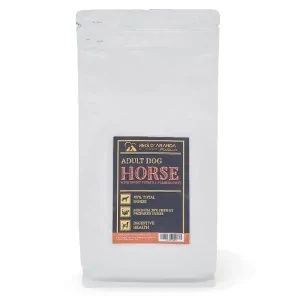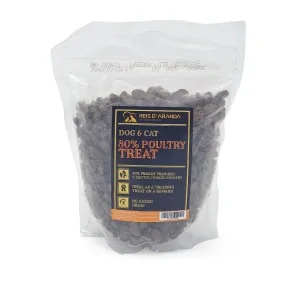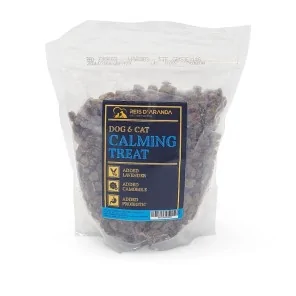Its name says it all: the Vienna blue rabbit comes from Austria. Not only is it beautiful with its shiny blue-grey...
THE AUSTRALIAN KELPIE
INTRODUCTION
The Australian Kelpie, commonly known as the Kelpie, is a breed of dog that originated in Australia in the late 19th century. This breed was developed to meet the need for a hardy and adaptable sheepdog, capable of handling flocks of sheep in the varied and often harsh Australian conditions.
THE ORIGIN OF THE AUSTRALIAN KELPIE
The inhospitable and unfamiliar environment of Australia forced the English and Scottish settlers to select working dogs that were suited to the conditions of the country (much larger spaces, much larger flocks of unruly Merino lambs, and the tremendous heat). The moh (as the flock is called in Australia) had to be gathered into pens on the ranch or station to spend the night protecting them from the Aboriginal dingoes and to keep them from getting lost. This required a really hard-working dog who knew how to gather and manage the flock, rather than the typical shepherd of his native country.
Many areas of England had developed their own line of shepherds, almost always named after the region or the owner. Most of these have been lost today, but by 1800 some were still in existence when emigration to Australia boomed. At that time, many other breeds were introduced to Australia, and those that were best suited to the new environment were used and subsequently crossed with other local breeds.
One of the first types that proved ideal for Australian conditions was the Rutherford line of North County Collies. These dogs were short-haired, erect-eared or semi-erect, and black or black and tan in colour, and were described by G. S. Kempe as ‘of sturdy build and courageous temperament [...] with a large head and strong jaws’.
Several members of the Rutherford family emigrated from Scotland to Australia, and received a good lot of these dogs from relatives. Other people soon saw the abilities of these dogs and wanted puppies from this line. There is some doubt as to whether they remained one hundred percent pure, as pragmatic herd owners crossed their good working bitches with the best dogs they could find, regardless of their pedigree. But the Rutherford line formed the basis for the breed now known as the kelpie.
In the late 19th century, a rancher named Gleason traded a horse for a black and tan female puppy bred in Victoria from imported parents of the Rutherford line. He named her Kelpie (a shifting water spirit from Celtic mythology), and found her to be a splendid worker. The bitch was known as Gleason's Kelpie, and her offspring gave the breed its name. This original Kelpie was crossed twice with Moss, a black Australian dog, of the Rutherford line, and then with ‘Caesar’, a black and tan dog of pure Scottish parentage. The latter litter with Caesar would produce the most famous kelpie in history. A black and tan bitch, also called kelpie, who was given to G. T. W. W. King as a gift. His kelpie (the second) would go on to win the first working herding dog competition in Australia. This victory increased interest in the line.
The kelpie breed is based on these beginnings, with crosses over the years with other lines. The breed is essentially English, with no introduction of the dingo. Many good black working dogs came out of the line created on ‘Moss’, especially one called ‘Barb’. For many years it was believed that the blacks were a separate breed called barb. There were other lines known by the names of their best dogs or their owner, but soon they were all unified under the name of kelpie.
THE AUSTRALIAN KELPIE STANDARD
GENERAL APPEARANCE: This should be that of an active and useful dog; a strong muscular condition combined with elasticity of limbs gives the ability to work tirelessly. His appearance should not reflect weakness.
IMPORTANT PROPORTIONS: The length of the dog, measured from the front point of the forechest in a straight line towards the protuberance of the ischium, is greater than the height at the withers in a ratio of 10:9.
HEAD : The head should be in proportion to the size of the dog. Overall, the shape and contour of the head impart a fox-like expression, but this is tempered by the almond shape of the eyes.
CRANIAL REGION:
SKULL: Slightly rounded and broad between the ears. Seen from the side, the forehead slopes in a straight line towards the naso-frontal depression.
NASO-FRONTAL DEPRESSION (STOP): Marked.
FACIAL REGION:
TRUFFLE: Its colour harmonises with the colour of the coat.
HOCOCO: Clearly moulded and defined, preferably slightly shorter than the skull.
BELLIES: Tight and clearly defined, without slackness.
TEETH : Teeth should be strong, sound and regularly aligned. The lower incisors are placed closely behind the upper incisors, i.e. the articulation should be scissor-like.
CHEEKS: Neither thick nor prominent, but round towards the muzzle.
EYES: Almond-shaped, of medium size and well defined angle. Intelligent and alert expression. The colour should be brown, harmonising with the colour of the coat. Lighter coloured eyes are permitted in the case of dogs with blue coat.
EARS: Ears erect, ending in a fine point; the auricular concha is thin, but strong at the base. The ears are set wide apart, inclining outwards and forming a slight curve at the outer edge. They are of medium size. They are well furnished with hair on the inside.
NECK: Moderate length, strong, slightly arched, gradually sloping into the shoulders. No dewlap present, but a fairly abundant ruff of hair.
BODY:
UPPER LINE: Firm and even.
LOIN: Strong and well muscled; the flanks are deep.
Croup: Rather long and sloping.
CHEST: Deep, muscular and moderately broad. Ribs well sprung and well sprung back, not barrel-shaped.
TAIL: In repose should hang slightly arched. When the dog is in motion or at attention it may be raised, but under no circumstances should it extend beyond the vertical line of the root of the tail.
It should be provided with abundant brush hair. Set on in harmony with the slope of the croup and should reach approximately to the hock.
LIMBS:
FOREQUARTERS: FORELEGS:
GENERAL APPEARANCE: Muscular, strong but not coarse boned, straight and parallel when viewed from the front.
Should be well defined. Muscled and well laid back, shoulder blades close together at the withers.
Upperarm should be at right angles to the shoulder blade.
ELBOWS: Should neither turn in nor out.
METACARPUS: Viewed from the side, the metacarpals should be slightly sloping to allow flexibility of movement and the ability to turn quickly.
HANDS / FOREQUARTERS FEET: Should be round and strong. Thick pads. Fingers close together and well arched; nails short and strong.
HIND LEGS:
GENERAL APPEARANCE: Should be broad and strong. Seen from behind, the hindquarters from the hocks to the feet are straight and parallel, neither close together nor too wide apart.
KNEES: Well angulated.
Hocks: Set fairly close to the ground.
FEET: Should be round and strong. Thick pads. Toes close together and well arched; nails short and strong.
GAIT / MOVEMENT: To display the boundless vigour and perseverance required of a sheepdog working in open spaces, the Kelpie must be of very robust build and possess a perfect gait. The movement must be loose and effortless and the dog must be able to turn suddenly without slowing down. As the speed increases during the trot, the feet tend to come closer together when they rest on the ground; but when the dog is at rest, all four feet are in correct perpendicular position.
COAT:
COAT: The coat is double, with a short, dense undercoat. The outer coat is tight, the hairs are of a harsh, close lying texture, so that the coat is rain resistant. Under the body, towards the back of the limbs the coat is longer, and near the thigh it forms a light ‘trousers’. On the head (including the inside of the ears), on the front of the limbs and feet, the coat is short. On the neck it is long and thick, forming a ruff. The tail should be provided with a thick brush. Too long or too short a coat is a fault. In general, the hair on the body should be approximately 2-3 cm in length.
COLOUR: Black, black and tan, red, red and tan, fawn, chocolate, smoke colour.
SIZE AND WEIGHT:
HEIGHT AT WITHERS:
- MALES: 46 - 51 cm
- FEMALES: 43 - 48 cm
FAULTS: Any departure from the foregoing points should be considered a fault and the seriousness with which the fault should be regarded should be in exact proportion to its degree and its effect upon the health and welfare of the dog and its ability to perform its traditional work.
SERIOUS FAULTS:
- Shoulders too loose.
- Any tendency to a cow or barrel hock.
- Crossed or zigzagging movement.
- Restricted movement or showing stiffness.
DISQUALIFYING FAULTS:
- Aggressiveness or extreme shyness.
- Any dog showing clear signs of physical or behavioural abnormalities.
N.B.: Male dogs should have two apparently normal appearing testicles fully descended into the scrotum.
Only functionally and clinically healthy dogs of typical breed conformation should be used for breeding.
THE HEALTH OF THE AUSTRALIAN KELPIE
The Kelpie is considered an exceptionally healthy breed with an average life expectancy of 14 years, but some studies recommend health testing for the following diseases:
- CEREBELIAL CORTICAL DEGENERATION (CCD): Cerebellar cortical degeneration (CCD) is a neurodegenerative disease process that affects many breeds of dogs. The disease affects a specific area of the brain known as the cerebellum. In cerebellar degeneration, cells within the cerebellum die, causing neurological symptoms in dogs. The age of onset varies from newborn to early onset in weeks to months. Symptoms include abnormalities in walking, wide stance, swaying, muscle tremors with eating and activity, head tilt, loss of coordination and abnormal posture.
- KRABBE'S DISEASE: Krabbe's disease, also known as globoid cell leukodystrophy or GALC deficiency, is a severe metabolic disorder that causes neuromuscular problems such as weakness and paralysis. It is caused by a recessive mutation in the GALC gene. Affected puppies show tremors, limb weakness, ataxia (loss of coordination), muscle atrophy and paralysis at approximately 4-6 weeks of age. The disease is progressive and, by the age of 9 months, symptoms are likely to be severe enough to warrant euthanasia on humane grounds.
THE AUSTRALIAN KELPIE AS A PET
Although friendly and easy to train, its high energy and willingness to work make it unsuitable for indoor or flat living. It is very much a one-owner dog, and although loyal and intelligent, it is very independent, which is essential for its work.
The kelpie is very intelligent, industrious and always alert. He has a docile disposition and an almost inexhaustible energy. On the other hand, he shows great loyalty and devotion to work. He has a natural instinct for working with sheep, both in the field and in the pen. Due to his great muscular capacity in conjunction with his great energy and elasticity, he can be considered one of the best disposed dogs for work in general.
The statistics of the work it saves are staggering, and many American farmers are becoming aware of the value of these dogs. Although by nature a sheep herder, the kelpie can also be trained for cattle. The kelpie bred to work cattle is strong, and many can lead as well as push. They can be very useful in rounding up sheep, leading them into pens, putting them through baths, getting them into trucks and wagons, and even ‘riding’ them (weighing them on their backs) if they get stuck in the loading chute. A team of kelpies may be sent to round up a herd of cattle, while the owner waits at the corral gate. They can put them through veterinary vaccinations, help load them, and drive them down the road to another pasture.
The kelpie has also been effective with pigs, horses, goats, poultry and even reindeer.
They are hard workers, and stories abound of the exploits of the breed, despite being badly injured.
They are also used for purposes other than herding, such as search and rescue, guide dog and drug detection.
CONCLUSION
The Kelpie is a pure working breed that requires committed and active families who do not keep him on the couch all the time, but find ways to give him all the mental and physical exercise he needs to avoid behavioural problems and compulsive disorders. An amazing breed and highly recommended for families living on farms or for sporting herding enthusiasts.
Leave a comment
Log in to post comments
















